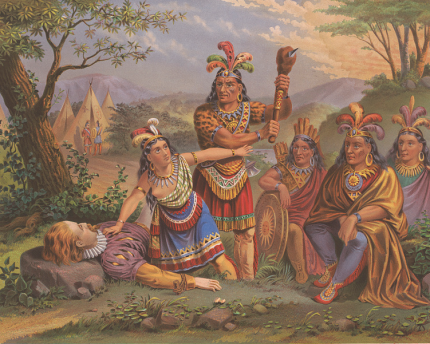Pocahontas: Separating history from myth

Pocahontas remains beloved, however, known for helping the colonists and eventually marrying another Englishman, John Rolfe. Now, descendants of the Powhatan tribes of Pocahontas could be given federal recognition under a measure approved by Congress earlier this month. The six Virginia tribes are the:
- Chickahominy.
- Eastern Chickahominy.
- Upper Mattaponi.
- Rappahannock.
- Monacan.
- Nansemond.
But who was Pocahontas, and why is she remembered? Here is the rundown:
Birth: She was born sometime around 1595 or 1596 in the Tidewater region of Virginia. Her father was Powhatan, also called Wahunsenacah, chief.
Name: At birth, she was called Matoaka. She also was known as Amonute. But the name known best to the English was Pocahontas, which translates as “little wanton” or “mischievous one,” according to Encyclopedia Britannica.
Jamestown: She was a girl when the English settled in the Chesapeake Bay in 1607. While accounts vary, Pocahontas would have been about 11 or 12 that year. John Smith, a leader of the Colony, reported that Pocahontas saved his life, physically shielding him when he was to be executed. Some historians believe that the Smith made up the story. Another theory is that Smith misunderstood what was happening, and that he was being adopted into the tribe. (See the National Park Service website for more.)
Trouble with the colonists: The new settlers could be needy guests. In 1608-09, they visited Powhattan’s tribes to trade trinkets for corn. The tribes weren’t interested, as drought had reduced their harvests, the park service website recounts. The English made threats and even burned towns to get food. A series of conflicts ensued. In the winter of 1609–10, about three-quarters of the colonists in Virginia died of starvation. The survivors were later joined by reinforcements and attacked the tribes. “Using terror tactics borrowed from Queen Elizabeth I's conquest of Ireland, English soldiers burned villages and towns and executed women and children,” according to the Encyclopedia Virginia online.
Not a diplomat, but close: Beyond the romanticized folklore, Pocahontas did meet Smith. Accounts describe her as an informal liaison between her father and the colonists.
Hostage: In 1610, when Pocahontas would have been a teenager, she married an American Indian named Kocoum. Three years later, in the spring of 1613, Capt. Samuel Argall captured her and used her as a bargaining chip to make peace.While Powhatan agreed to the English demands, Pocahontas was learning English and being taught the colonists' religion at an English settlement called Henrico. She met widower John Rolfe and the two married in 1614. The park service account explains that once Powhatan received word that his daughter was married, the marriage between Pocahontas and Kocoum would have been considered over. But in their book The True Story of Pocahontas: The Other Side of History, (Fulcrum Publishing; 2007) Linwood "Little Bear" Custalow and Angela L. Daniel Silver Star write that Kocoum "was killed by the English after Pocahontas was kidnapped."
Pocahontas was baptized a Christian and took the name Rebecca. Her marriage led to a lull in the fighting known as the “peace of Pocahontas.”
A new role: The Virginia Company of London, a joint-stock company formed to establish a colony in North America, took an interest in Pocahontas. The company thought her marriage to Rolfe could generate interest in the settlement. The family traveled to England in 1616, and the young woman now called Rebecca Rolfe toured the country and met royalty. She and her husband moved to Brentford. They had a son, Thomas.
In England, Pocahontas again crossed paths with Smith, who had spread the legendary stories about her. But when she encountered Smith, she became angry at him for the way he treated her father and the tribe, the park service recounts.
Death: The Rolfe family was to return to Virginia in 1617, but Pocahontas became ill and was taken ashore before they crossed the ocean. Just 21 years old, she died in the town of Gravesend.
Resources:
- The True Story of Pocahontas: The Other Side of History, (Fulcrum Publishing; 2007), Linwood "Little Bear" Custalow and Angela L. Daniel Silver Star.
- Encyclopedia Britannica: Pocahontas.
- Encyclopedia Britannica: John Rolfe.
- Encyclopedia Britannica: First Anglo-Powhatan War.
- National Park Service: Pocahontas, Her Life and Legend.
- Office of Sen. Mark Warner, D-Virginia: Warner & Kaine Secure Final Passage of Bill Granting Recognition of Virginia Indian Tribes.
Related:
A dark December -- the Conestoga massacre
History course provokes thought -- and attacks
Follow StudyHall.Rocks on Twitter or like us on Facebook and tell us what you think.

